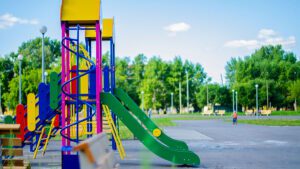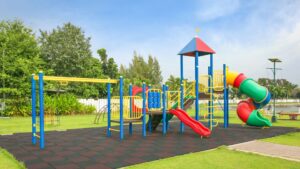Открытие батутного парка может быть интересным и потенциально прибыльным бизнесом. Но это еще и капиталоемкий бизнес. Если вы всерьез намерены открыть парк, вам нужен четкий бюджет, который покрывал бы первоначальные расходы на создание парка, обеспечение безопасности и соблюдение норм, текущую деятельность, а также подушку безопасности на случай непредвиденных обстоятельств.
Краткое содержание (если вы торопитесь)
- Типовой объем запуска (оборудование + отделка): $233,000–$467,000 (оценка среднего парка)
- Страхование (ежегодное): $5,800–$11,700 (оценка)
- Основные факторы, влияющие на стоимость: строительство (покупка или аренда), выбор оборудования, реконструкция помещения, подбор персонала, маркетинг, системы безопасности и техническое обслуживание.
- Совет: Планируйте поэтапно: откройте основные достопримечательности, а затем добавьте новые возможности, когда денежный поток стабилизируется.

1. Объяснение основных первоначальных затрат
1.1 Строительство: купить, арендовать или построить новое?
- Покупка Обеспечивает долгосрочную стабильность, но требует больших первоначальных затрат и, возможно, капитального ремонта. Ожидайте более высоких потребностей в капитале, но большего контроля.
- Аренда Снижает первоначальный капитал и позволяет быстрее открыться, но условия аренды могут ограничивать возможности для структурных изменений (и арендная плата может вырасти).
- Новое строительство идеально подходит для создания индивидуального макета, но занимает больше времени (часто год или больше) и стоит дороже.
Ваш выбор определяет многие последующие расходы: ОВКВ, требования к высоте потолков, конструктивные опоры для высоких аттракционов и парковка.
1.2 Оборудование и аттракционы (крупные товары)
Современные батутные парки - это многофункциональные центры. Как правило, они включают в себя:
- Открытые прыжковые батутные площадки
- Дорожки для кувыркания
- Пенопластовые ямы и воздушные подушки
- Площадки для игры в доджбол
- Слэм-данк/баскетбол на батуте
- Полосы препятствий в стиле ниндзя
- Интерактивные и AR-функции
Средний бюджет на оборудование для парка среднего размера оценивается в $200k-$400k. Этот диапазон зависит от количества и разнообразия аттракционов, персонализации, а также от того, насколько новое или подержанное оборудование.
1.3 Планировка, безопасность и конструктивные работы
Не экономьте:
- Напольное покрытие и противоударные накладки
- Пожарные выходы, спринклеры, детекторы дыма
- Прочные структурные опоры и крепления
- Освещение, звук и вентиляция
- Доступ ADA и туалеты
Эти затраты на строительство во многом зависят от состояния выбранного вами здания, но часто могут конкурировать с затратами на оборудование в старых объектах.

2. Эксплуатационные расходы, которые вы должны заложить в бюджет
2.1 Персонал
Батутный парк требует большого количества персонала. Роли включают:
- Стойка регистрации/приемная
- Обслуживающий персонал батута/надзиратели (персонал по безопасности)
- Персонал, работающий с продуктами питания и напитками (если применимо)
- Координаторы мероприятий (вечеринки, корпоративные заказы)
- Уборщики и техники по обслуживанию
- Менеджер и помощники менеджера
Правило большого пальца: на каждые ~30 игроков должен приходиться как минимум один обученный супервайзер. Если ваш парк работает долго (70+ часов в неделю), рассчитывайте на две полные команды.
2.2 Техническое обслуживание и запчасти
Оборудование требует постоянного внимания: замены набивки, пружин, ковриков и фурнитуры. Профилактическое обслуживание сокращает время простоя, но стоит денег. Планируйте годовой бюджет на обслуживание и отслеживайте циклы замены быстроизнашивающихся предметов.
2.3 Маркетинг и привлечение клиентов
Выделите значимый бюджет на маркетинг:
- Местная цифровая реклама (Google/FB/Instagram)
- Мероприятия и партнерство со школами
- PR и работа с населением
- Сезонные акции
Сильный маркетинговый план на этапе открытия очень важен для ускорения распространения информации из уст в уста и раннего бронирования для вечеринок и групп.
2.4 Страхование и управление рисками
Страховка не подлежит обсуждению. Первоначальная оценка $5,000-$10,000 в год ежегодно. Это покрывает риски, связанные со зданием/имуществом, и страхование ответственности. Фактические страховые взносы зависят от местоположения, истории претензий, мер безопасности и лимитов покрытия.
Инвестируйте в обучение персонала и документированные системы безопасности - страховщики поощряют операторов с меньшим риском более выгодными ставками.

3. Стратегии финансирования
3.1 Общие пути финансирования
- Банковские кредиты / коммерческое кредитование: традиционный вариант; сравните процентные ставки и условия погашения.
- Долевые инвесторы: Инвестор может вложить капитал в обмен на право собственности, но при этом ожидать изменений в управлении и ожидать выхода.
- Гранты: Редко когда в качестве развлечения, но некоторые местные гранты на экономическое развитие или фонды для малого бизнеса могут применяться.
- Финансирование поставщиков/аренда в собственность: Иногда производители оборудования предлагают варианты финансирования.
3.2 Советы по бюджету
- Поэтапное развертывание: откройте основные достопримечательности и добавьте специализированные функции позже.
- Консервативные прогнозы доходов: Не переоценивайте посещаемость - стройте свой кассовый план на реалистичных цифрах.
- Резервный фонд: сохранять резерв (10-20% от первоначальных капитальных затрат) на случай непредвиденного превышения расходов.

4. Планировка и впечатления гостей
4.1 Поток и видимость
Продумайте четкие линии обзора, чтобы контролеры и родители могли легко следить за активностью. Отделите высокоэнергетические зоны (доджбол, курсы ниндзя) от зон для малышей и семейного отдыха.
4.2 Пространства для вечеринок и мероприятий
Празднование дней рождения и групповые мероприятия являются драйверами прибыли - спроектируйте специальные залы для проведения вечеринок, чтобы обеспечить эффективный оборот и повысить продажи.
4.3 Продукты питания и напитки
Добавьте простое кафе или закусочную, чтобы получать прибыль за время работы. Рассмотрите возможность сдачи в аренду партнеру, если ресторанный бизнес не является вашей основной специализацией.
4.4 Доступность и инклюзивность
Обеспечьте соответствие требованиям ADA и продумайте сенсорные занятия для посетителей с нейроразвитием.

5. Безопасность и соблюдение требований: неотъемлемые условия
- Соблюдайте местные строительные нормы и правила, а также все отраслевые стандарты безопасности.
- Внедрить письменные правила безопасности, вывески и ознакомительные инструктажи под руководством персонала.
- Ведите ежедневные контрольные списки и журналы технического обслуживания.
- Предложите аптечки первой помощи, AED и обученный персонал на месте.
Надежные системы безопасности снижают ответственность и повышают доверие клиентов, что крайне важно для долгосрочного успеха.

6. Потоки доходов и рычаги получения прибыли
- Общий вход и почасовая плата за прыжки
- Вечеринки по случаю дня рождения и групповые заказы
- Членские билеты и абонементы
- Товары и концессии
- Корпоративные мероприятия и пакеты для тимбилдинга
- Специальные мероприятия во внеурочное время (занятия фитнесом, батутные лиги)
Максимизируйте расходы на одного посетителя с помощью дополнительных услуг (носки, шкафчики, фотопакеты).

7. Практические советы от операторов
- Проведите глубокое исследование рынка: демографические показатели, конкуренция, школьные календари и чувствительность к местным ценам.
- Выбирайте местоположение с умомДоступность и парковка имеют не меньшее значение, чем арендная плата.
- Приоритет безопасностиОдин-единственный инцидент, связанный с безопасностью, может подорвать репутацию.
- Нанимайте и обучайте хорошо: высококвалифицированный персонал обеспечивает безопасность и возвращение гостей.
- Начните с малого и расширяйтесь: проверьте свою концепцию, а затем масштабируйте.
Батутный парк может стать как центром веселья в обществе, так и прибыльным бизнесом - но только при условии тщательного планирования. Реалистично планируйте первоначальный капитал (ожидайте ≈ $233k-$467k для среднего объекта), учесть ежегодную страховку (≈ $5.8k-$11.7k), а также уделять первостепенное внимание безопасности и маркетингу с самого первого дня. При грамотном финансировании, поэтапном развертывании и эффективной работе вы сможете создать устойчивый и веселый аттракцион, который заставит клиентов возвращаться.




